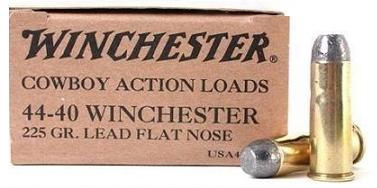In 1873, Winchester introduced the gun that would be known as “The Gun that Won the West”—the Winchester 1873 lever action rifle, chambered in .44 WCF (Winchester Center Fire.) The same year, Colt introduced the 1873 Colt SAA revolver in Colt .45 and the US Army introduced the .45-70 Government.

Colt, realizing that western settlers wouldn’t want to carry different types of ammunition for their rifles and side arms, decided to chamber their 1873 SAA revolvers in .44 WCF—though they renamed the .44 WCF to .44-40 (.44 caliber and 40 gains of black powder) in order to prevent giving Winchester free advertising.
Winchester never reciprocated by chambering any of its guns in Colt .45.
Today, most lever gun reproductions are chambered in the Colt .45 for two reasons. First, the rims on modern Colt .45s are stronger than their 19th Century counterparts; and second, .44-40 Winchester ammunition is rather scarce.
If you have considered buying or reloading the .44-40 Win, here are some helpful recommendations from my experience.
The original .44-40 Win had a nominal bullet diameter, around .427”. But all of the reproduction guns have .429” diameter, primarily because very few .44-40 Win are produced these days—at least, compared to the .429” .44 Magnum and .44 Special rounds. Manufacturers generally don’t want to produce all of the sizes, which can cause some problems for the hand loader of a .44-40.
Although current 1873 model revolvers made by Uberti have chamber necks that normally will clear .429” bullets, Pietta revolvers have slightly tighter chambers that can be problematic unless you follow the correct procedures.
You can always load an undersized .427” bullet, but in addition to the difficulty you’ll have with finding .427” bullets, you may also end up with accuracy problems.
Some of us that shoot the .44-40 Win do so for the experience of shooting authentic Cowboy caliber guns. And because the Cowboys only had lead cast bullets, I recommend them, too. Many of us shoot cast lead bullets .001” over the groove diameter for best accuracy, but the .44-40 Win is the exception to this rule due to its .429” groove diameter.
Even though all modern .44-40 Win guns are .429”, reloading dies are normally sold with a .427” expander plug. For best results, you should get a .429” expander plug for a .44 Magnum/.44 Special.
Next, because the brass on the .44-40 Win is thinner than any modern ammunition, the cases tend to buckle when roll crimping, which can cause a bulge in the neck area that prevents the round from chambering correctly. To avoid this problem, you can simply use a Lee factory crimp die instead of roll crimping.
For brass, I think Starline’s reloading brass is top-quality. For bullets, Missouri Bullet Company manufactures Cowboy bullets of the appropriate hardness and profile in 205 grain, 210 grain and 240 grain.
For those who would like to try casting bullets, Lee Precision makes several inexpensive bullets molds for this round for less than $20.00 and lead casting electric pots for around $60.00. It’s not necessary to size Lee bullets, but they also have inexpensive sizing dies should you want to size your bullets.
Lee also makes a bullet lubricant that I like to use—I simply dump the bullets in a plastic gallon baggie, pour in the Lee liquid bullet lubricant, knead the bullets in the bag for a few minutes, and then dump them out onto a paper pate to dry overnight. I’ve had great success using simple range lead recovered from both my back stop and the public range. Accuracy is fine with little to no leading.
For powder, you have a variety of options, but for this type of cartridge it’s hard to beat Vihtavuori Tin Star, also known as N32C. I generally use 9.6 grains of Tin Star for 205 grain, 210 grain, and 240 gr bullets; that amount fills the case nearly to the base of the bullet. In my 7 ½” revolver, I can achieve 875 FPS without any pressure issues. Tin Star also burns incredibly clean with virtually no residue left in the spent case.
If you decide to load black powder, either FF or FFF will work, but with black powder, you must fill the case completely and preferably have a slightly compressed load. Once you fire black powder, you must clean both your gun and the brass. Wash the brass with hot, soapy water and rinse several times soon after shooting to prevent the brass from corroding. Don’t let the brass soak to long, either. In my experience, it’s best to flush out as much burned powder as possible with hot water, then soak the brass in soapy water for 5-10 minutes and rinse again. To dry the brass, you can set it aside or use a small food dehydrator, which will dry the brass in about 15 minutes.
If you have questions about reloading .44-40 Wins or other ammunition, comment below or contact us! We’d love to help you learn more about reloading so you can get started.
